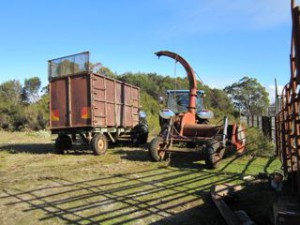King Kunzea May 16, 2016
Is this just another one of those mystical, conceptual, fantasy essential oils from Australia or is it something real? Well we can tell you this one is 100% real!!! Why is that you ask, then read on……
Kunzea has been around for a number of years, pioneered in its early days by farmer John Hood on the Australian Island State of Tasmania. Producing a few hundred kilos a year, Kunzea found itself in a few small boutique aromatherapy brands but was always the underachiever in comparison to essential oils like tea tree. Well we feel that this could now change having seen the investment recently made to upscale production in order to reach new markets.
Kunzea ambigua or ‘White Cloud’ is native to Southern Victoria, Tasmania and the Bass Strait Islands including Flinders, which lies off the north east coast of Tasmania. The plant is a large shrub growing 3-5 metres in height, flowering in the spring, which in this region is from late August until December.
The oil itself is known for its therapeutic values. The local TGA (Australia Therapeutic Goods Act) referencing evidence of it assisting with the ‘temporary relief of pain associated with arthritis and for the relief of muscular, tendon and joint aches and pains.’ The oil also offers ‘temporary relief for symptoms of influenza.’ The official TGA listing is AUSTL 72143. Google this reference for more information on its associated benefits.

Fully grown bush prior to harvesting
A number of essential oils can lay claim to similar therapeutic benefits so what makes this one actually work, or considered as better than others? Well it has a high content of important sesquiterpene compounds (C15), in fact it has five!! This is impressive as many other essential oils only contain 2 or 3. Kunzea is the only one known to contain so many. It is these sesquiterpines that provide the anti-inflammatory benefits, relieving inflammation in a powerful way. The five C15 compounds present in Kunzea are globulol, viridiflorol, spathulenol, ledol and bicyclogermacrene. We’ve highlighted viridiflorol for a reason. Keep reading.
Another reason why Kunzea is different from other essential oils is its unusual biochemical properties. Its two major constituents are alphapinene and 1,8 cineole. The pinene is present in a larger percentage than the cineole, which is very unusual, in that the opposite is the case for most other similar essential oils, taking Eucalyptus as an example. The presence and ratio of these two compounds gives Kunzea its powerful properties for treating all manner of respiratory conditions. Its low percentage of cineole also means that it is very safe to use on the skin, another good feature for use within topical applications as Kunzea is largely considered to be a non-irritant.
Viridiflorol is highlighted due to the fact that some of the oil recently distilled is particularly high in this component potentially enhancing its performance as an anti-inflammatory. We believe that harvested at the right time increases the level of viridiflorol in the yield. Further trials surrounding harvesting techniques are currently being investigated along with ways to isolate this molecule. Viridiflorol is also found in Niaouli, Tea Tree and Eucalyptus essential oils. Analytically Kunzea oil commonly looks like this:
| Compound | % |
| Alpha-pinene | 45-50% |
| 1,8 cineole | 11-13% |
| Alpha-terpineol | 2% |
| Bicyclogermacrene | 4-5% |
| Globulol | 7-9% |
| Viridiflorol | 7+% |
In relative terms work with Kunzea has only just started. Dr. Daniel Pénoël, a renowned French physician who specialises in the therapeutic use of essential oils, gives high praise to Kunzea essential oil and is currently conducting studies to see if it can be used as a treatment in capsule form for Crohn’s Disease.
Kunzea’s main THERAPEUTIC BENEFITS can be broken down into the following attributes with references compiled from various sources including Mark Webb’s book ‘Bush Sense’.
INFLAMMATION – Again referring to Dr Pénoël’s work he reported the case of a patient of his whom he treated for severe inflammation inside her lungs as a side effect of radiotherapy for breast cancer treatment. Her lungs were not infected, simply inflamed, as though they had been burnt. During treatment with Kunzea, her body’s inflammatory reaction decreased and her energy levels improved. When the Kunzea treatment was stopped after two weeks, her energy level dropped significantly and her inflammatory response started to rise again.

Typical wild harvesting of Kunzea in Tasmania
MUSCLE PAINS – Mark Webb, a well-known Australian aromatherapist, lists that Kunzea promotes rapid repair of soft tissue injuries, such as sprains and strains. This is backed up in a number of other publications.
MICROBIAL INFECTIONS – Kunzea’s anti-infectious and antimicrobial properties can be effective if treated at the first signs of a common cold.
Kunzea is also excellent for respiratory and throat infections when used in a throat gargle or steam inhalation. Kunzea also has the added benefit that its anti-inflammatory properties are effective in soothing inflamed respiratory passages and lungs.
The results of microbiological testing undertaken by Tasmanian Laboratory Services show that Kunzea oil is effective against staphylococci and legionella. Mark Webb mentions Kunzea’s effectiveness against Staphylococcus aureus, Pseudomonas aeruginosa, Escherichia coli, and the fungal Candida albicans.
DENTAL PAIN – Kunzea oil has successfully been used as a dental antiseptic and anti-inflammatory.
In applying neat Kunzea oil, several times daily, the inflammation cleared up and bacterial growth can be stopped.
Beyond aromatherapy and as a PERFUMERY INGREDIENT it is being recognised as something unique in the green herbaceous family and can already boast a number of references. Its fragrance is clean, fresh, and medicinal with a hint of spice.
Kunzea is an interesting product with a great story that can add a unique twist to many FRAGRANCES and medicinal products. In our dynamic market each product must have something unique as well as being a great functioning item, so why not give Kunzea a try?
 Ultra International B.V.
Ultra International B.V.
